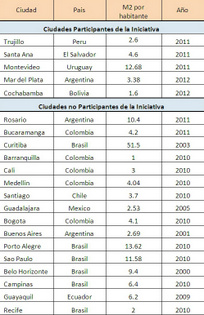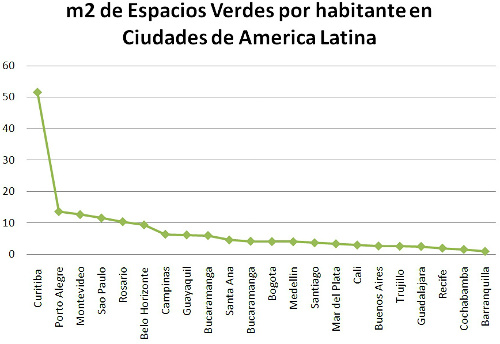Friday, April 19, 2024
News and Views from the Global South

Tierramerica
The Soul of Buenos Aires Is Turning Grey

The fenced-in Plaza Francia park in the Buenos Aires neighbourhood of Recoleta. Credit: Fabiana Frayssinet/IPS
- If cities have souls, the Argentine capital’s is turning more and more grey. Real estate speculation, the fencing in and paving of parks, and the installation of private bars and restaurants in public squares have changed the face of the city. Green spaces with carefully tended flower beds? Today they’re found mainly in the nostalgia brought on by a classic tango song.
Buenos Aires used to be green, and springtime was bursting with colours, thanks to all the flowering trees.
That is what you see in photos from last century, in parks like El Rosedal – the Rose Garden – and in verses from songs like the one immortalised by legendary tango singer Carlos Gardel about “the little path that time has erased…lined with clover and flowering reeds.”
Time has erased the little paths – and the green spaces they crossed. Things have changed so much in the so-called “Paris of the pampas” since the era – 1880 to 1930 – when the city parks, inspired by those in the French capital, were created.

Green spaces per inhabitant in some Latin American cities. Credit: ESCI/IBD
“The soul of Buenos Aires used to be the identity of each neighbourhood, where families would sit in chairs outside, where there was a sense of trust in the streets, where the street, the squares and the entire city were like a continuation of the home…things have been diluted now into a kind of city where everything is sort of the same, pretentious and exclusive,” the writer Gabriela Massuh wrote in an article in “Ñ” magazine in November 2014.
In its State of Latin American and Caribbean Cities 2012 report, U.N. Habitat cites a World Health Organisation (WHO) recommendation that cities should have at least nine to 11 sq metres of green space per capita.
“Concretely, the city needs at least 70 new plazas to reach the number of square metres of green space recommended by WHO,” Massuh, the author of “El robo de Buenos Aires” (The Theft of Buenos Aires – Sudamericana publishing company 2014), told Tierramérica.
According to the U.N. Habitat report, the variety of criteria for defining green space and its irregular distribution in urban areas makes it difficult to calculate the real average.
In 2014, the city government launched the Buenos Aires Green Plan, aimed at mitigating the effects of the damage caused by climate change, reducing temperatures in the city, cutting energy consumption and curbing greenhouse gas emissions.
The plan reported that green spaces in the city proper (which accounts for three million of the total Greater Buenos Aires population of 13 million) covered 1,129 hectares, equivalent to 3.9 sq metres per capita.
Estimates by the Inter-American Development Bank’s (IDB) Emerging and Sustainable Cities Initiative (ESCI), also based on the WHO recommendation, indicate that Buenos Aires is one of the least green cities in the region.
One of the heads of ESCI, Horacio Terraza, said that with the exception of Curitiba in southern Brazil, which has as many green spaces as cities in northern Europe, the Latin American cities studied leave a great deal to be desired in terms of green areas.
The other cities that meet healthy standards with regard to the amount of green space, besides Curitiba (with 51.3 sq metres per capita), are Porto Alegre (13.62) and São Paulo (11.58) in Brazil, followed by Montevideo in Uruguay (12.68), Rosario in Argentina (10.4) and Belo Horizonte in Brazil (9.4).

Ranking of Latin American cities according to green space per capita and square metres. Credit: ESCI/IBD
In Buenos Aires, the deterioration of green spaces began during the 1976-1983 military dictatorship, when city squares were paved over and cement structures were built in parks as a symbol of development.
According to Massuh, this tendency continued after the return to democracy, during the neoliberal years of the 1990s, and again since 2007, when neo-conservative Mayor Mauricio Macri took office in Buenos Aires.
“The method of ‘militarising’ public spaces is very similar to that used by the military to reform green spaces under the pretext of security,” she said.
“Instead of proposing better lighting or greater involvement by local residents in taking care of the squares, the grass turned into cement, paved bike lanes were laid in green spaces – like what is happening in the Palermo neighbourhood, which has turned into an oven in the summer because of the paving over of open ground – and fences have begun to be put up to keep the homeless from using the squares and parks at night,” she added.
According to Massuh, this “clean-up makes green spaces and shade in the summer exclusive, keeping poor people out,” and will not be mitigated by the Buenos Aires Green Plan.
Among other measures seeking to turn Buenos Aires into a green city, the 20-year Green Plan promises to guarantee green spaces “no more than 350 metres away for every local resident,” build 12 parks and 78 squares, refurbish 30 and plant one million trees in 10 years – one for every three inhabitants.
But she said the green plan is contradicted by initiatives like a city project which, although it has not gone ahead due to the protests it triggered, meant to install a garbage truck terminal on seven of the 350 hectares of the Costanera Sur Ecological Reserve on the banks of the Rio de la Plata, considered a major green lung for the city.
Another example was the concession free of charge of 15 of the 20 hectares of Roca Park, “one of the few spaces with creative potential in the city,” to build a truck cargo terminal, which for now has been blocked in court.
The same thing is true of the authorisation for installing bars in squares and parks, which according to the city government increases their value in terms of service to the community.
“That ‘increase in value’ in the squares is a whitewash and it also increases the amount of cement and concrete and involves fencing them in…they don’t even keep the city lakes and ponds clean,” biologist Matías Pandolfi of the National Scientific and Technical Research Council (CONICET), told Tierramérica.
“Real estate speculation is our mega-mining or transgenic soy,” added Massuh, citing lawyer and environmental activist Enrique Viale, who describes “urban extractivism” as the expulsion of the population, the concentration of wealth and territory, the appropriation of public spaces, generalised damage to the environment, and the degradation of institutional life.
Pandolfi said that exploitation of urban natural resources hurts much more than the landscape “and is a hazard to the health of the citizens.”
“Through the process of photosynthesis trees absorb carbon dioxide and oxygenate the air. They also help regulate the water and heat cycles in the city,” he argued.
The appropriation of green areas is also reflected, Pandolfi said, by the fencing in of parks. A total of 86, one-third of the total, have already been fenced in, he said.
“To generate ecological awareness, green spaces must look as natural as possible…fencing in a public space, which is a democratic space par excellence, removes that, it’s greatest virtue,” he said.
Parks, said Pandolfi, are “hubs of social life and creators of citizen environmental awareness.”
“That’s why our surroundings have to be as natural as possible. What ecological conscience can be transmitted from a Starbucks or a McCafé installed in a park with fencing around it?” he asked.
Edited by Estrella Gutiérrez/Translated by Stephanie Wildes
This story was originally published by Latin American newspapers that are part of the Tierramérica network.

 Print
Print



